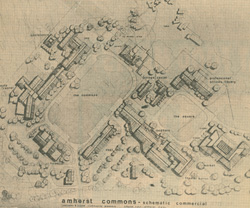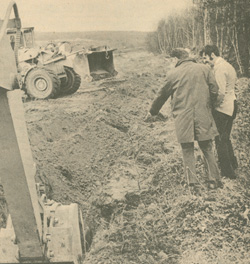Background on Amherst Growth Study Committee

View of the proposed the Amherst Fields
On May 7, 1971 Otto Paparazzo Associates announced their plans to develop 640 acres of land in east Amherst. With a proposed 2,200 residential units, a commercial center, and a golf course, residents of the town were concerned about unnatural growth of the community and about the environmental impact of such a development. Indeed objections to the Paparazzo development were voiced almost immediately after their plans to build were announced. During the first Zoning Board of Appeals meeting on July 29th residents pointed to environmental concerns in response to the corporation's request for a golf course. Fear that fertilizers and herbicides might pollute the town's water supply halted the project and the Zoning Board called for Paparazzo Associates to submit a master plan of the entire project before approving any individual piece of it.
A group of residents strongly opposed to the project joined forces soon after the board's decision. This group, which at first only communicated informally at public hearings and via letters to the editor of the local newspaper, quickly formalized their union as a citizens' action group with a defined purpose and membership. By the summer of 1971 the Amherst Growth Study Committee (AGSC) described itself as a "group of residents dedicated to finding socially, economically and environmentally sound alternatives to the ugly, piecemeal growth of the past decade and to the gigantic development called "The Commons" now planned for east Amherst."
With members of AGSC and non-members alike expressing serious concerns about the proposed project, the Zoning Board of Appeals held a public hearing on September 9th to review and discuss the Paparazzo development. This time residents stressed the town's need to build schools and sewers to keep up with current growth--a need magnified if the Paparazzo development was approved. By late September the Zoning Board decided against the project, and by first of October Paparazzo announce it had withdrawn its application. During the same time that residents of the town and members of AGSC were expressing their objections to the project, the town's Planning Board and Board of Selectmen issued statements in support of the development. At a town meeting held a few days later, residents voted to amend the zoning by-laws to prohibit further construction of apartment housing in Neighborhood Residential zones and in Planned Unit Residential Development (PURD). On the heels of this change in the zoning by-laws, Paparazzo asked the Planning Board to disregard the withdrawal of its application for a definitive subdivision plan and submitted a new PURD application which requested the construction of 1,328 units, just a little more than half the earlier request. This new plan was approved, and on December 23, 1971 the Zoning Board issued a permit to begin construction.
In response to the Zoning Board's decision, the AGSC was officially incorporated on January 10, 1972 and the following day filed a Bill of Complaint in the Superior Court of Northampton to appeal the decision and reverse the construction permit. The complaint alleged that the Paparazzo project was approved after the zoning by-laws were amended to prohibit apartment housing in a PURD, thereby granting an exception that exceeded the Board's authority. Furthermore the AGSC pointed out that the Board did not take into account the water pollution that would result from the Paparazzo development, overlooking the fact that the current sewage treatment plant was designed for a maximum flow rate of 4 million gallons per day and was often already exceeding this flow rate and discharing excess flow into the Connecticut River without treatment.
Paparazzo Associates wasted no time in responding to the AGSC's appeal, filing a motion to dismiss the suit. On February 12, 1972 a ruling was made in favor of Paparazzo citing that the AGSC was not an "aggrieved person." This decision was based on the fact that the AGSC was incorporated after the decision by the Zoning Board of Appeals was made and that it did not own any real property in Amherst. Within a month, AGSC filed a preliminary appeal from the ruling to the Supreme Judicial Court. Paparazzo asked that the appeal be dismissed, but the judge denied the request. Paparazzo Associates then sued the AGSC and its two directors, Ellsworth Barnard and Dana Snyder, in September 1972 for a total of $1,000,000. During this time Paparazzo filed an application with the Amherst Conservation Commission for the construction of a pond within the development. The Commission made its recommendation to the State Department of Natural Resources (DNR), and the DNR issued an order to prohibit work until it could review the application. It was soon discovered, however, that work continued, and a cease and desist order was issued immediately in response. In October 1972 AGSC sought an injunction against Paparazzo from the Board of Selectmen until their current legal action against the project could be resolved; a request that was voted down.
By March 1973 as the battled waged on, the AGSC wrote Thomas C. McMahon, the State Director of the Division of Water Pollution Control, seeking guidance with the potential sewer issues the town faced should construction begin on the Amherst Fields. The group cited an earlier study which indicated that the Paparazzo development once complete would result in an minimum flow of 400,000 gallons per day, a flow rate that would tax the already overloaded sewage treatment facility. As a result, the state banned sewer connections in Amherst until the town could devise a plan that would address the problem. This state ban was the final, albeit unexpected, blow to the project. In March 1974, Paparazzo Associates dropped the case against the AGSC and Dana Snyder. After a two-year struggle to prevent the development of east Amherst, the Amherst Growth Study Committee dissociated in December 1974.


